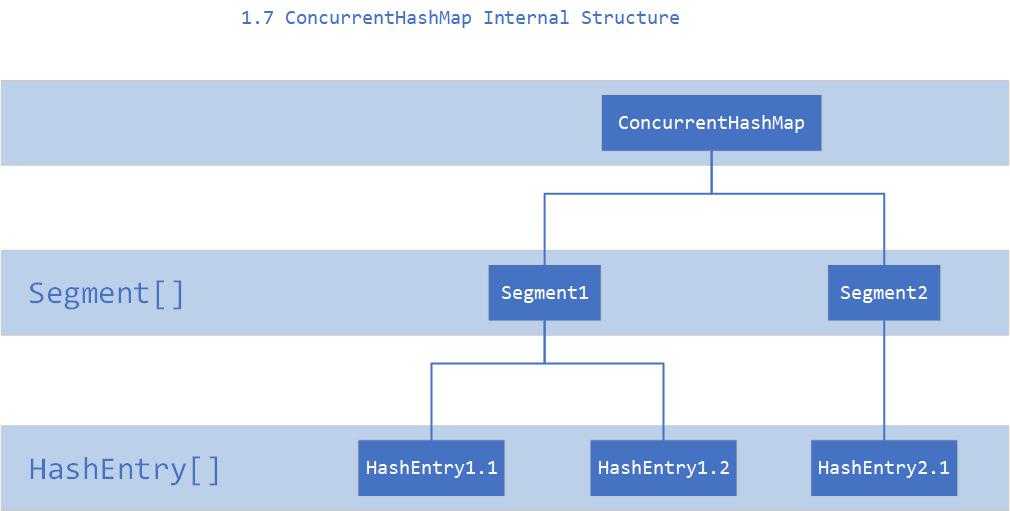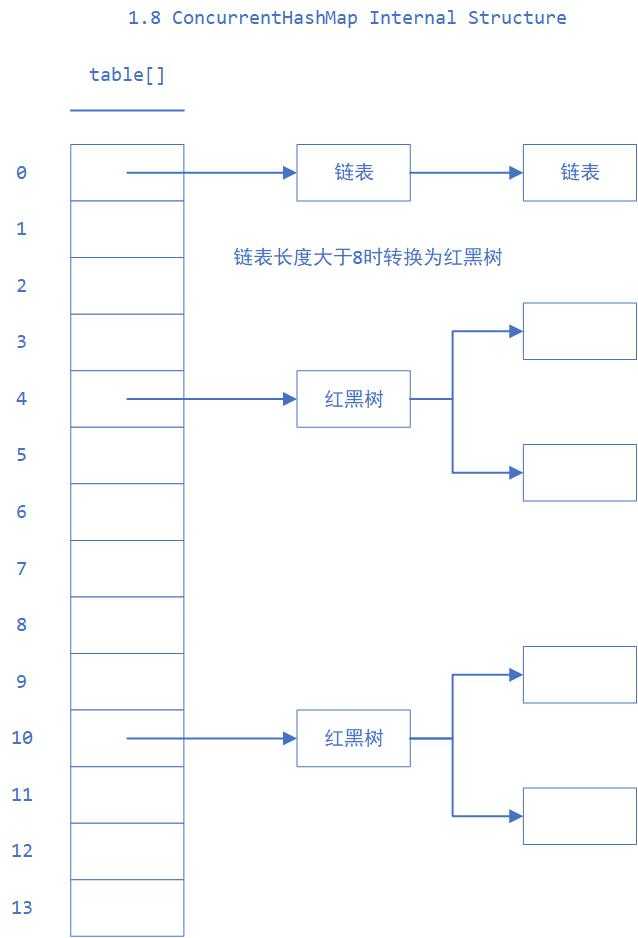标签:OLE 方式 寻址 point pos new ceo alt bit
在JDK1.7&1.8源码对比分析【集合】HashMap中我们对比分析了JDK1.7和1.8版本的HashMap源码,趁热打铁,这篇文章就来看看JDK1.7和1.8版本的ConcurrentHashMap有哪些区别。
一、对比分析
1. 1.7版本
2. 1.8版本
先来看看 1.7 的实现,下面是他的结构图:

如上图所示,是由 Segment 数组、HashEntry 组成,和 HashMap 一样,仍然是数组 + 链表。
它的核心成员变量:
/** * The segments, each of which is a specialized hash table. * Segment 数组,存放数据时首先需要定位到具体的 Segment 中 */ final Segment<K,V>[] segments; transient Set<K> keySet; transient Set<Map.Entry<K,V>> entrySet;
Segment 是 ConcurrentHashMap 的一个内部类,主要的组成如下:
static final class Segment<K,V> extends ReentrantLock implements Serializable { private static final long serialVersionUID = 2249069246763182397L; /** * The maximum number of times to tryLock in a prescan before * possibly blocking on acquire in preparation for a locked * segment operation. On multiprocessors, using a bounded * number of retries maintains cache acquired while locating * nodes. */ static final int MAX_SCAN_RETRIES = Runtime.getRuntime().availableProcessors() > 1 ? 64 : 1; /** * The per-segment table. Elements are accessed via * entryAt/setEntryAt providing volatile semantics. * 和 HashMap 中的 HashEntry 作用一样,真正存放数据的桶 */ transient volatile HashEntry<K,V>[] table; /** * The number of elements. Accessed only either within locks * or among other volatile reads that maintain visibility. */ transient int count; /** * The total number of mutative operations in this segment. * Even though this may overflows 32 bits, it provides * sufficient accuracy for stability checks in CHM isEmpty() * and size() methods. Accessed only either within locks or * among other volatile reads that maintain visibility. */ transient int modCount; /** * The table is rehashed when its size exceeds this threshold. * (The value of this field is always <tt>(int)(capacity * * loadFactor)</tt>.) */ transient int threshold; /** * The load factor for the hash table. Even though this value * is same for all segments, it is replicated to avoid needing * links to outer object. * @serial */ final float loadFactor; }
看看其中 HashEntry 的组成:
/** * ConcurrentHashMap list entry. Note that this is never exported * out as a user-visible Map.Entry. */ static final class HashEntry<K,V> { final int hash; final K key; volatile V value; volatile HashEntry<K,V> next; HashEntry(int hash, K key, V value, HashEntry<K,V> next) { this.hash = hash; this.key = key; this.value = value; this.next = next; } }
和 HashMap 非常类似,唯一的区别就是其中的核心数据如 value ,以及链表都是 volatile 修饰的,保证了获取时的可见性。
原理上来说:ConcurrentHashMap 采用了分段锁技术,其中 Segment 继承于 ReentrantLock。不会像 HashTable 那样不管是 put 还是 get 操作都需要做同步处理,理论上 ConcurrentHashMap 支持 CurrencyLevel (Segment 数组数量)的线程并发。每当一个线程占用锁访问一个 Segment 时,不会影响到其他的 Segment。
下面也来看看核心的put、get方法。
@SuppressWarnings("unchecked")
public V put(K key, V value) {
Segment<K,V> s;
if (value == null)
throw new NullPointerException();
int hash = hash(key);
int j = (hash >>> segmentShift) & segmentMask;
if ((s = (Segment<K,V>)UNSAFE.getObject // nonvolatile; recheck
(segments, (j << SSHIFT) + SBASE)) == null) // in ensureSegment
s = ensureSegment(j);
return s.put(key, hash, value, false);
}
final V put(K key, int hash, V value, boolean onlyIfAbsent) {
HashEntry<K,V> node = tryLock() ? null :
scanAndLockForPut(key, hash, value);
V oldValue;
try {
HashEntry<K,V>[] tab = table;
int index = (tab.length - 1) & hash;
HashEntry<K,V> first = entryAt(tab, index);
for (HashEntry<K,V> e = first;;) {
if (e != null) {
K k;
if ((k = e.key) == key ||
(e.hash == hash && key.equals(k))) {
oldValue = e.value;
if (!onlyIfAbsent) {
e.value = value;
++modCount;
}
break;
}
e = e.next;
}
else {
if (node != null)
node.setNext(first);
else
node = new HashEntry<K,V>(hash, key, value, first);
int c = count + 1;
if (c > threshold && tab.length < MAXIMUM_CAPACITY)
rehash(node);
else
setEntryAt(tab, index, node);
++modCount;
count = c;
oldValue = null;
break;
}
}
} finally {
unlock();
}
return oldValue;
}
虽然 HashEntry 中的 value 是用 volatile 关键词修饰的,但是并不能保证并发的原子性,所以 put 操作时仍然需要加锁处理。
首先第一步的时候会尝试获取锁,如果获取失败肯定就有其他线程存在竞争,则利用scanAndLockForPut()自旋获取锁。
private HashEntry<K,V> scanAndLockForPut(K key, int hash, V value) { HashEntry<K,V> first = entryForHash(this, hash); HashEntry<K,V> e = first; HashEntry<K,V> node = null; int retries = -1; // negative while locating node while (!tryLock()) { // 尝试自旋获取锁 HashEntry<K,V> f; // to recheck first below if (retries < 0) { if (e == null) { if (node == null) // speculatively create node node = new HashEntry<K,V>(hash, key, value, null); retries = 0; } else if (key.equals(e.key)) retries = 0; else e = e.next; } else if (++retries > MAX_SCAN_RETRIES) { // 如果重试的次数达到了 MAX_SCAN_RETRIES 则改为阻塞锁获取,保证能获取成功 lock(); break; } else if ((retries & 1) == 0 && (f = entryForHash(this, hash)) != first) { e = first = f; // re-traverse if entry changed retries = -1; } } return node; }
再看看put的流程:
final V put(K key, int hash, V value, boolean onlyIfAbsent) { HashEntry<K,V> node = tryLock() ? null : // 1. 将当前 Segment 中的 table 通过 key 的 hashcode 定位到 HashEntry scanAndLockForPut(key, hash, value); V oldValue; try { HashEntry<K,V>[] tab = table; int index = (tab.length - 1) & hash; HashEntry<K,V> first = entryAt(tab, index); for (HashEntry<K,V> e = first;;) { if (e != null) { K k; // 2. 遍历该 HashEntry,如果不为空则判断传入的 key 和当前遍历的 key 是否相等,相等则覆盖旧的 value if ((k = e.key) == key || (e.hash == hash && key.equals(k))) { oldValue = e.value; if (!onlyIfAbsent) { e.value = value; ++modCount; } break; } e = e.next; } // 3. 不为空则需要新建一个 HashEntry 并加入到 Segment 中,同时会先判断是否需要扩容 else { if (node != null) node.setNext(first); else node = new HashEntry<K,V>(hash, key, value, first); int c = count + 1; if (c > threshold && tab.length < MAXIMUM_CAPACITY) rehash(node); else setEntryAt(tab, index, node); ++modCount; count = c; oldValue = null; break; } } } finally { // 4. 最后会解除在 1 中所获取当前 Segment 的锁 unlock(); } return oldValue; }
public V get(Object key) { Segment<K,V> s; // manually integrate access methods to reduce overhead HashEntry<K,V>[] tab; int h = hash(key); long u = (((h >>> segmentShift) & segmentMask) << SSHIFT) + SBASE; if ((s = (Segment<K,V>)UNSAFE.getObjectVolatile(segments, u)) != null && (tab = s.table) != null) { for (HashEntry<K,V> e = (HashEntry<K,V>) UNSAFE.getObjectVolatile (tab, ((long)(((tab.length - 1) & h)) << TSHIFT) + TBASE); e != null; e = e.next) { K k; if ((k = e.key) == key || (e.hash == h && key.equals(k))) return e.value; } } return null; }
get 逻辑比较简单:
只需要将 Key 通过 Hash 之后定位到具体的 Segment ,再通过一次 Hash 定位到具体的元素上。
由于 HashEntry 中的 value 属性是用 volatile 关键词修饰的,保证了内存可见性,所以每次获取时都是最新值。
ConcurrentHashMap 的 get 方法是非常高效的,因为整个过程都不需要加锁。
1.7 已经解决了并发问题,并且能支持 N 个 Segment 这么多次数的并发,但依然存在 HashMap 在 1.7 版本中的问题。那就是查询遍历链表效率太低。
因此 1.8 做了一些数据结构上的调整。首先来看下底层的组成结构:

看起来是不是和 1.8 HashMap 结构类似?
其中抛弃了原有的 Segment 分段锁,而采用了CAS + synchronized来保证并发安全性。
static class Node<K,V> implements Map.Entry<K,V> { final int hash; final K key; volatile V val; volatile Node<K,V> next; Node(int hash, K key, V val, Node<K,V> next) { this.hash = hash; this.key = key; this.val = val; this.next = next; } public final K getKey() { return key; } public final V getValue() { return val; } public final int hashCode() { return key.hashCode() ^ val.hashCode(); } public final String toString(){ return key + "=" + val; } public final V setValue(V value) { throw new UnsupportedOperationException(); } public final boolean equals(Object o) { Object k, v, u; Map.Entry<?,?> e; return ((o instanceof Map.Entry) && (k = (e = (Map.Entry<?,?>)o).getKey()) != null && (v = e.getValue()) != null && (k == key || k.equals(key)) && (v == (u = val) || v.equals(u))); } /** * Virtualized support for map.get(); overridden in subclasses. */ Node<K,V> find(int h, Object k) { Node<K,V> e = this; if (k != null) { do { K ek; if (e.hash == h && ((ek = e.key) == k || (ek != null && k.equals(ek)))) return e; } while ((e = e.next) != null); } return null; } }
也将 1.7 中存放数据的 HashEntry 改为 Node,但作用都是相同的。其中的val、next都用了 volatile 修饰,保证了可见性。
重点来看看 put 函数:
public V put(K key, V value) { return putVal(key, value, false); } /** Implementation for put and putIfAbsent */ final V putVal(K key, V value, boolean onlyIfAbsent) { if (key == null || value == null) throw new NullPointerException(); // 根据 key 计算出 hashcode int hash = spread(key.hashCode()); int binCount = 0; for (Node<K,V>[] tab = table;;) { Node<K,V> f; int n, i, fh; // 判断是否需要进行初始化 if (tab == null || (n = tab.length) == 0) tab = initTable(); // f 即为当前 key 定位出的 Node,如果为空表示当前位置可以写入数据,利用 CAS 尝试写入,失败则自旋保证成功 else if ((f = tabAt(tab, i = (n - 1) & hash)) == null) { if (casTabAt(tab, i, null, new Node<K,V>(hash, key, value, null))) break; // no lock when adding to empty bin } // 如果当前位置的 hashcode == MOVED == -1,则需要进行扩容 else if ((fh = f.hash) == MOVED) tab = helpTransfer(tab, f); else { V oldVal = null; synchronized (f) {// 如果都不满足,则利用 synchronized 锁写入数据 if (tabAt(tab, i) == f) { if (fh >= 0) { binCount = 1; for (Node<K,V> e = f;; ++binCount) { K ek; if (e.hash == hash && ((ek = e.key) == key || (ek != null && key.equals(ek)))) { oldVal = e.val; if (!onlyIfAbsent) e.val = value; break; } Node<K,V> pred = e; if ((e = e.next) == null) { pred.next = new Node<K,V>(hash, key, value, null); break; } } } else if (f instanceof TreeBin) { Node<K,V> p; binCount = 2; if ((p = ((TreeBin<K,V>)f).putTreeVal(hash, key, value)) != null) { oldVal = p.val; if (!onlyIfAbsent) p.val = value; } } } } if (binCount != 0) { // 如果数量大于 TREEIFY_THRESHOLD 则要转换为红黑树 if (binCount >= TREEIFY_THRESHOLD) treeifyBin(tab, i); if (oldVal != null) return oldVal; break; } } } addCount(1L, binCount); return null; }
public V get(Object key) { Node<K,V>[] tab; Node<K,V> e, p; int n, eh; K ek; int h = spread(key.hashCode()); if ((tab = table) != null && (n = tab.length) > 0 && (e = tabAt(tab, (n - 1) & h)) != null) { // 根据计算出来的 hashcode 寻址,如果就在桶上那么直接返回值 if ((eh = e.hash) == h) { if ((ek = e.key) == key || (ek != null && key.equals(ek))) return e.val; } // 如果是红黑树那就按照树的方式获取值 else if (eh < 0) return (p = e.find(h, key)) != null ? p.val : null; // 都不满足那就按照链表的方式遍历获取值 while ((e = e.next) != null) { if (e.hash == h && ((ek = e.key) == key || (ek != null && key.equals(ek)))) return e.val; } } return null; }
1.8 在 1.7 的数据结构上做了大的改动,采用红黑树之后可以保证查询效率(O(logn)),甚至取消了 ReentrantLock 改为了 synchronized,这样可以看出在新版的 JDK 中对 synchronized 优化是很到位的。
JDK1.7&1.8源码对比分析【集合】ConcurrentHashMap
标签:OLE 方式 寻址 point pos new ceo alt bit
原文地址:https://www.cnblogs.com/warehouse/p/9420217.html